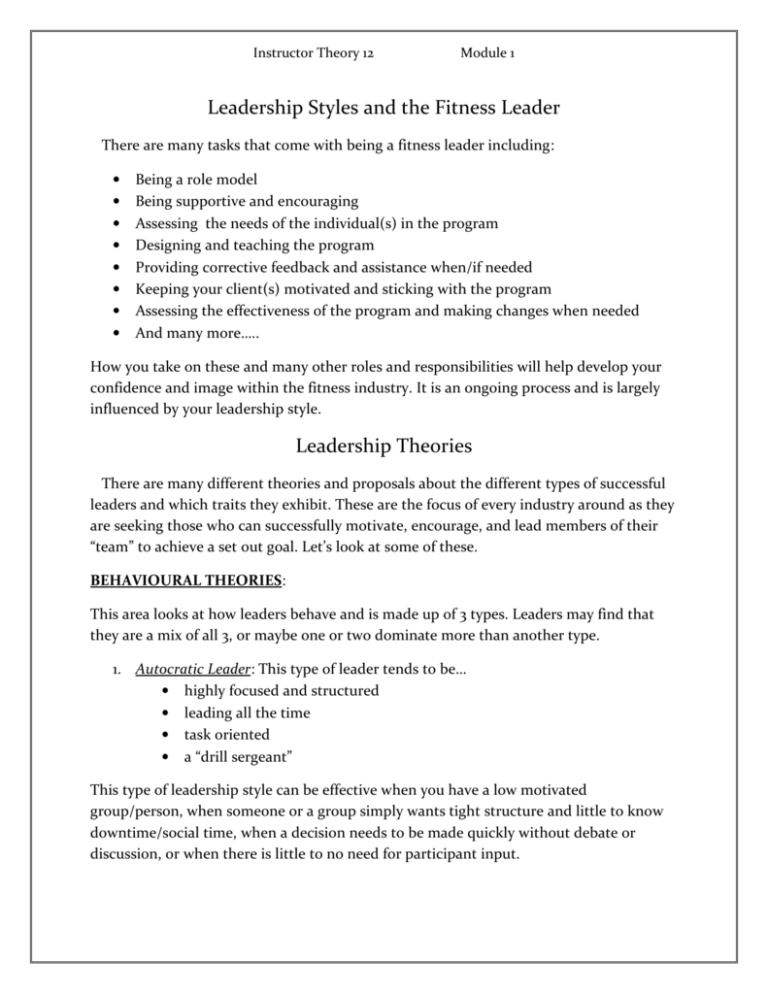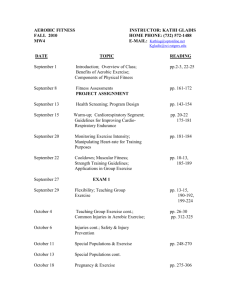Leadership Styles and the Fitness Leader Leadership Theories
advertisement

Instructor Theory 12 Module 1 Leadership Styles and the Fitness Leader There are many tasks that come with being a fitness leader including: • • • • • • • • Being a role model Being supportive and encouraging Assessing the needs of the individual(s) in the program Designing and teaching the program Providing corrective feedback and assistance when/if needed Keeping your client(s) motivated and sticking with the program Assessing the effectiveness of the program and making changes when needed And many more….. How you take on these and many other roles and responsibilities will help develop your confidence and image within the fitness industry. It is an ongoing process and is largely influenced by your leadership style. Leadership Theories There are many different theories and proposals about the different types of successful leaders and which traits they exhibit. These are the focus of every industry around as they are seeking those who can successfully motivate, encourage, and lead members of their “team” to achieve a set out goal. Let’s look at some of these. BEHAVIOURAL THEORIES: This area looks at how leaders behave and is made up of 3 types. Leaders may find that they are a mix of all 3, or maybe one or two dominate more than another type. 1. Autocratic Leader: This type of leader tends to be… • highly focused and structured • leading all the time • task oriented • a “drill sergeant” This type of leadership style can be effective when you have a low motivated group/person, when someone or a group simply wants tight structure and little to know downtime/social time, when a decision needs to be made quickly without debate or discussion, or when there is little to no need for participant input. Instructor Theory 12 Module 1 2. Democratic Leader: This type of leader tends to… • provide an opportunity for the participant(s) to have input • set goals with the team/individual • participate at times with the team members/individuals This type of leadership style can be effective when teambuilding is needed or when a team/group agreement is needed. While it does allow for all members to provide feedback and become involved in their assignment/task, it can create a problematic situation to form a final decision if there are too many options/ideas. 3. Laissez-Faire Leader: This type of leader tends to… • be more unstructured/less rigid in their decision making • allow many of the involved individuals to make the decisions • “go with the flow” This type of leadership style can be very useful to find creative solutions or activities, or when the group/individual is highly skilled, motivated and capable of self-direction. The downside to this style is that it could be a result of the leader becoming disinterested and/or lazy or distracted. Effective leaders will find that they have elements of each of these theories in their leadership styles and know when to embrace one style over another, or combine them. As a beginning fitness leader, it is very important to know who you are working with and which style is most effective to use with them. Knowing your preferred styles mixed with their goals and personality type will help you safely and effectively achieve the goals of your clients. Task vs. Person Oriented Whenever you work directly with people in a leadership role you will always have 2 underlying challenges: 1-Do you focus more on task completion rather than the person, or 2-do you focus more on the person rather than the task. For a fitness leader, this can be a challenge as focusing on the task more than the person can lead to feelings of not feeling welcomed/appreciated, whereas focusing more on the personal side instead of the tasks/goals could result in their fitness/health levels not changing. Successful fitness leaders find a way to balance this out with each client/group they work with. This delicate balancing act directly ties in to your behavioural leadership styles and could provide a clear picture of where your strengths are and what could be worked on. Instructor Theory 12 Module 1 Concern for people vs. concern for production chart Source: http://www.mindtools.com/pages/article/newLDR_73.htm This graph looks at 2 dimensions that guide a leader’s decision making: A) Concern for People – This is the degree to which a leader considers the needs of team members, their interests, and areas of personal development when deciding how best to accomplish a task. B) Concern for Production – This is the degree to which a leader emphasizes concrete objectives, organizational efficiency and high productivity when deciding how best to accomplish a task. Country Club Leadership – High People/Low Production This style of leader is most concerned about the needs and feelings of members of his/her team. These people operate under the assumption that as long as team members are happy and secure then they will work hard. What tends to result is a work environment that is very relaxed and fun but where production suffers due to lack of direction and control. For fitness leaders this can create a very fun atmosphere for their client(s), but perhaps it is too much of a social scene and not focused enough on the fitness/active part of their program. However, it could be a great way to make a strong connection with your client(s).This can be a big turn of for many people, but some may prefer the social part more than others. Instructor Theory 12 Module 1 Produce or Perish Leadership – High Production/Low People Also known as Authoritarian or Compliance Leaders, people in this category believe that employees are simply a means to an end. Employee needs are always secondary to the need for efficient and productive workplaces. This type of leader is very autocratic, has strict work rules, policies, and procedures, and views punishment as the most effective means to motivate employees. For fitness leaders, this is a classic autocratic leader who embraces the “my way or the highway” approach with a very structured class or workout session. While this may be what some people are looking for (“just want to go in, do my workout, then go home”), for others it could be a way to de-motivate them and turn them off from exercise. Be very careful with this method and be sure to know your client(s) very well in terms of their preferred styles. Impoverished Leadership – Low Production/Low People This leader is mostly ineffective. He/she has neither a high regard for creating systems for getting the job done, nor for creating a work environment that is satisfying and motivating. The result is a place of disorganization, dissatisfaction and disharmony. For fitness leaders this is a nightmarish leadership style. This is most likely the sign of someone who has become burnt out and lost their passion for being in the field. As a result the clients they work with will not become motivated and will likely be more turned off from exercise than they were before they began. Professional development courses/seminars are a great way to keep yourself fresh with new ideas to add to your programs to avoid this from happening. Middle-of-the-Road Leadership – Medium Production/Medium People This style seems to be a balance of the two competing concerns. It may at first appear to be an ideal compromise. Therein lies the problem, though: When you compromise, you necessarily give away a bit of each concern so that neither production nor people needs are fully met. Leaders who use this style settle for average performance and often believe that this is the most anyone can expect. For fitness leaders this is perhaps the beginning stages of losing passion for being in the field, or you are tired from working with the client/group. If you cannot find a way to bring some “fire” back into your program and planning you risk becoming an impoverished leader. Worse yet, your client(s) may pick up on your lack of belief in them and internalize that they cannot achieve their goal(s). Instructor Theory 12 Module 1 Team Leadership – High Production/High People According to the Blake Mouton model, this is the pinnacle of managerial style. These leaders stress production needs and the needs of the people equally highly. The premise here is that employees are involved in understanding organizational purpose and determining production needs. When employees are committed to, and have a stake in the organization’s success, their needs and production needs coincide. This creates a team environment based on trust and respect, which leads to high satisfaction and motivation and, as a result, high production. For the fitness leader, this style has you clearly explaining to the client(s) the importance of following all the steps to your program while being involved in the planning process. Doing this allows them to feel a part of it all and that they will not only let you down if they give up, but will also be letting themselves down. By realizing the need to undertake a lifestyle overhaul to meet the program’s needs and goals, the individuals will be that much more motivated to succeed and be a part of the process as opposed to simply exercising a few times a week. “Some leaders are very task-oriented; they simply want to get things done. Others are very people-oriented; they want people to be happy. And others are a combination of the two. If you prefer to lead by setting and enforcing tight schedules, you tend to be more productionoriented (or task-oriented). If you make people your priority and try to accommodate employee needs, then you’re more people-oriented. Neither preference is right or wrong, just as no one type of leadership style is best for all situations. However, it's useful to understand what your natural leadership tendencies are, so that you can then begin working on developing skills that you may be missing.” Source: http://www.mindtools.com/pages/article/newLDR_73.htm This information comes from the listed website on leadership styles and provides a great insight into the many different ways leaders lead. Each leader has their own style and needs to learn how to use them effectively at the most appropriate times. There is no absolute “best” style, but rather each situation will determine which style is most effectively used.







